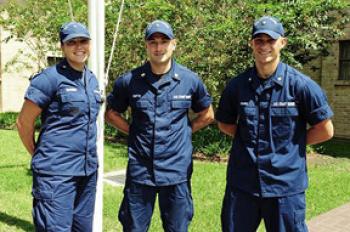
Coast Guard mission: A safer, cleaner tomorrow
By CARLOS VEGA
Petty Officer 3rd Class,
U.S. Coast Guard
MORGAN CITY — Forget the mundane.
This is a mission that is often synonymous with anonymous, as its agents and incidents can be difficult to record. Because, the worst case, end-of-the-world very thing that should have, could have or would have happened — did not. In the Coast Guard, an ounce of prevention is often worth a sound hose.
Since the events of Deepwater Horizon, oil spills have been a hot button issue in our country.
The men and women of the Coast Guard, in conjunction with the Environmental Protection Agency, work diligently day in and day out to protect the workers and prevent pollution.
“The EPA covers more of the land side of the facility, the storage tanks and all of the processing equipment,” said Petty Officer 3rd Class Will Kahms, a facility inspector at Coast Guard Marine Safety Unit Morgan City. “We inspect facilities to make sure they are in compliance with applicable federal regulations to prevent pollution. A lot of our regulations have to do with inspecting the hoses that transfer oil from the facility to the vessel.”
SU Morgan City’s 75,000 square-mile area of responsibility covers a significant portion of the Gulf of Mexico, 172 miles of the Gulf Intracoastal Waterway, the Barataria-Terrebonne Estuary, and the Atchafalaya Basin. Its area of responsibility includes more than 20,000 miles of oil and natural gas pipelines, 442 waterfront facilities, more than 1,900 offshore oil and gas platforms and an increasing number of floating offshore installations.
Not only is the Morgan City AOR roughly the size of South Dakota it further includes the Louisiana Offshore Oil Port, the nation’s only deepwater oil port which also handles 14 percent of the country’s foreign oil imports, and the Port of Fourchon, Louisiana’s only sea port on the Gulf of Mexico which serves as a land base for LOOP and supports 60 percent of the offshore oil and gas industry along with commercial and recreational fishing vessels.
The facility inspections department at MSU Morgan City performs more than 160 yearly facility inspections. Some facilities also include an additional secondary security inspection; the security systems in place are inspected to make sure they function properly, and the Coast Guard facility inspectors make sure they are doing the drills and exercises that are required to be within regulations.
“The operations manual generally refers to the transfer of oil or hazardous material from the facility to the vessel and has a step-by-step guide of how the transfer occurs and what steps they take in connecting and disconnecting their transfer equipment,” said Kahms. “Each operations manual is going to tell you who is specifically designated and trained to operate the transfer of oil or hazardous material safely from facilities to the vessel.”
Facility inspectors, like Kahms, check every facility operations manual and the facility response plan to make sure it is up to date and accurate.
The facility response plan is a good tool that they have because it will give the facility pre-determined booming strategies, pre-determined spill management teams,” said Petty Officer 3rd Class Britany Mckibben, a pollution responder at MSU Morgan City. “It will explain each duty of each Incident Command System position if any of them find themselves in that scenario. You can actually flip through the plan, read what their position is and what their duties will entail.”
In pollution cases, marine science technicians serve as the eyes and ears of the captain of the port.
Anytime there is an oil spill in the water, witnesses are legally required to contact the National Response Center. MSU Morgan City receives 13 percent of all NRC phone calls and performs follow up investigations on each case at an average of 12 to 17 cases a week.
“Here in Morgan City most of our oil spills are from industry, our first and foremost priority is always going to be the safety of the people, there will almost always be an oil spill response organization contracted out by the company,” said Mckibben. “Our job will be to supervise the cleanup. We act as a second set of eyes on the overall picture and act as liaisons between the Morgan City captain of the port and the company responsible for the spill and the company that is cleaning up.”
With five petty officers in the facility inspection department and six petty officers in the pollution response department, there is always a massive ongoing mission to protect people and the environment.
“I enjoy going out and knowing that I am going to help clear a deficiency. It’s nice to know that I have that purpose, that I have that role,” said Mckibben. “My favorite part is being able to work with a company and taking a side-by-side approach to correct deficiencies that will make things safer or more efficient.”
With every deficiency found, the Coast Guard plays a vital role in preventing the spills of hazardous substances in the water. It also builds trust between federal agencies, the industry and the public by assisting the nation in transporting its resources safely.
“What we do helps build partnerships between the Coast Guard, the industry and the community,” said Petty Officer 1st Class Tadd Martin, a facility inspector at MSU Morgan City. “The best part of my job is educating the community. It’s good to get out there and let them know that we are looking out for the safety of the people and environment.”
Coast Guardsmen such as Kahms, Mckibben and Martin often work in dynamic behind-the-scene roles that play such an important part in the Coast Guard mission of prevention.
They foster a safer, cleaner tomorrow for a great swath of the Gulf Coast.
- Log in to post comments
